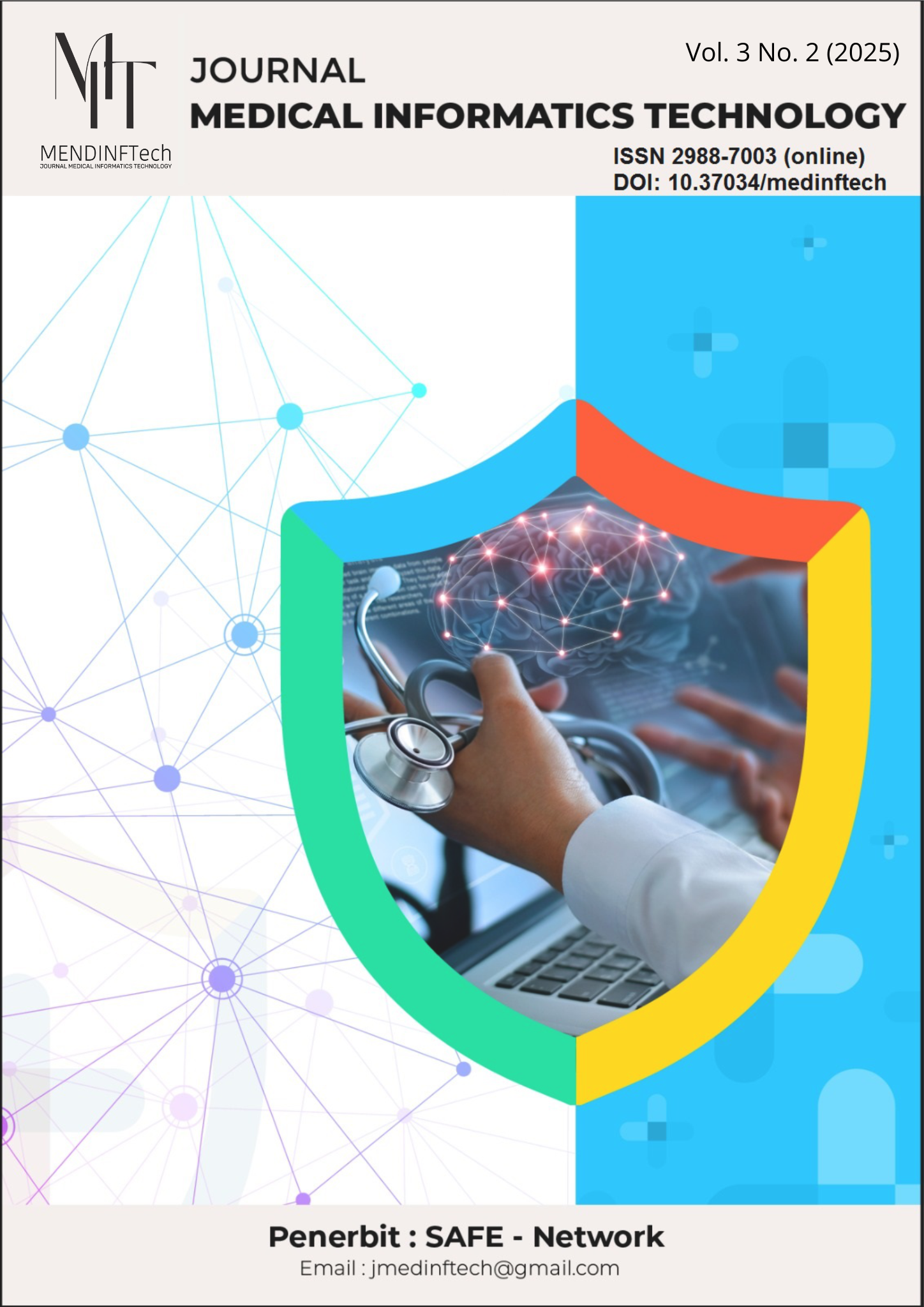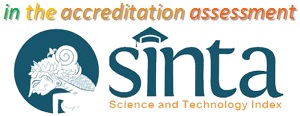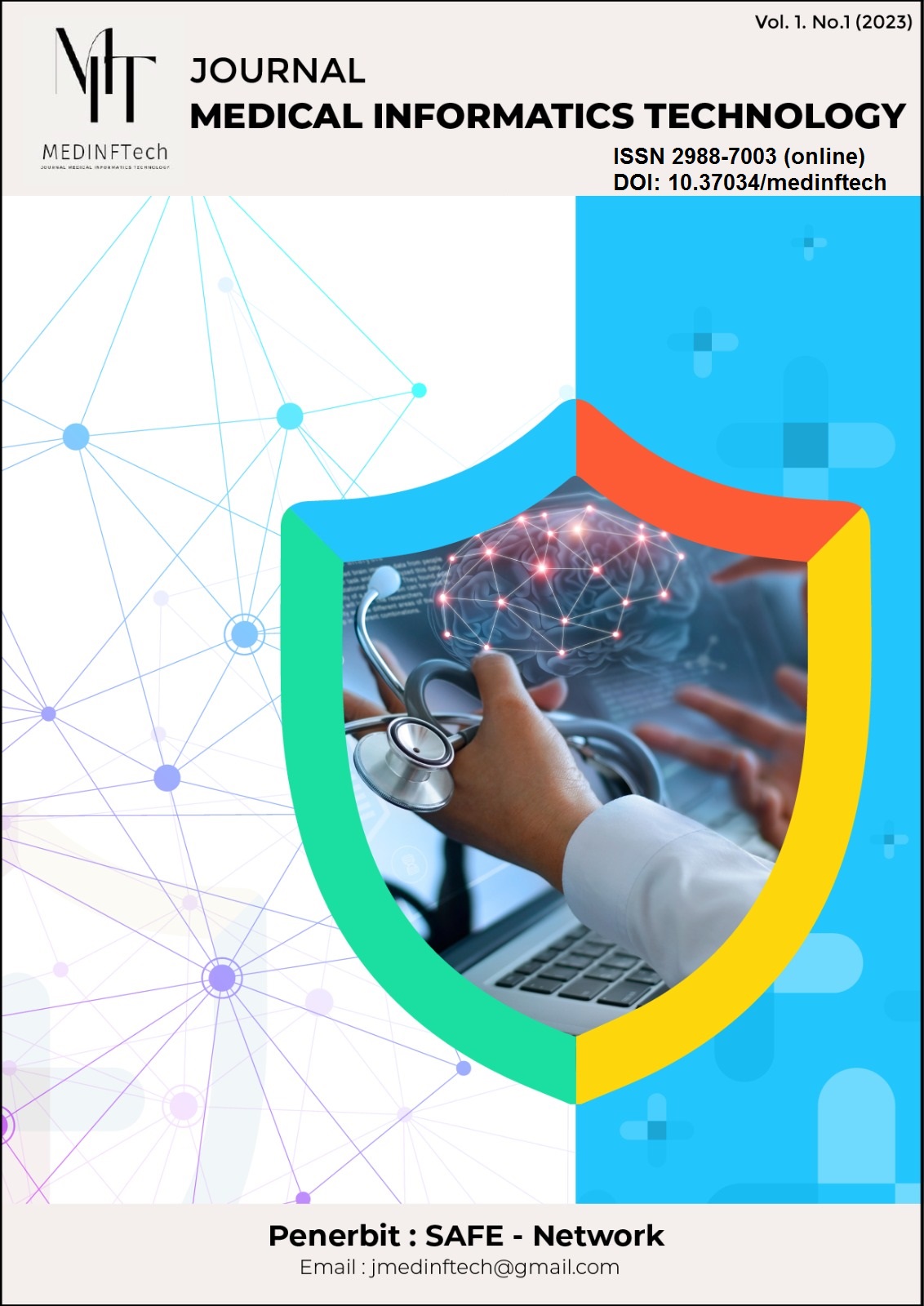Image Analysis of Skin Diseases Using DenseNet-121 Architecture
DOI:
https://doi.org/10.37034/medinftech.v3i2.99Keywords:
Deep Learning, DenseNet-121, Dermatitis, Psoriasis, TineaAbstract
Skin diseases such as dermatitis, psoriasis, and tinea often exhibit similar visual characteristics, which can lead to frequent errors in early diagnosis. Accurate diagnosis is critical, as each disease requires different treatment approaches. This study aims to develop an automated classification model for these three skin diseases using a deep learning approach based on the DenseNet-121 architecture, which consists of 121 layers designed to facilitate efficient feature reuse and gradient flow. The dataset consists of 300 labeled images, evenly distributed among the three disease classes. To enhance model generalization, preprocessing steps were applied, including data normalization and augmentation techniques such as image rotation (±20°), horizontal and vertical flipping, random zooming (range 0.8-1.2×), and brightness adjustment (±20%). The model was trained and validated using a stratified 5-fold cross-validation strategy. Experimental results demonstrated an overall classification accuracy of 94.59%, with high precision and recall scores across all classes. These results indicate the potential of using DenseNet-based deep learning models as decision support tools for early skin disease diagnosis. Further validation with larger datasets and clinical input from dermatologists is recommended to ensure reliability in real-world healthcare settings. Visual comparison through Grad-CAM heatmaps was also conducted to enhance interpretability and validate model focus on relevant skin features.
Downloads
References
W. Hary Cahyati, N. Siyam, and Karnowo, “Pengembangan Buku ‘Aksi Santri’ Sebagai Upaya Early Detection Penyakit Kulit,” Higeia J. Public Heal. Res. Dev., vol. 1, no. 3, pp. 625–634, 2021, [Online]. Available: http://journal.unnes.ac.id/sju/index.php/higeia
I. N. Cahyawati and I. Budiono, “Faktor yang Berhubungan dengan Kejadian Dermatitis Pada Nelayan,” J. Kesehat. Masy., vol. 6, no. 2, pp. 134–141, 2011.
E. S. S. Daili, S. L. Menaldi, and I. M. Wisnu, “Penyakit Kulit Yang Umum Di Indonesia: Sebuah Panduan Bergambar,” pp. 1–107, 2018.
G. E. P. Purba, S. Hadi Wijoyo, and N. Y. Setiawan, “Pengaruh Transfer Learning Resnet Dan DensenetTerhadap Performa Klasifikasi Ekspresi WajahMenggunakan Dataset Fer-2013,” vol. 1, no. 1, pp. 2548–964, 2017, [Online]. Available: http://j-ptiik.ub.ac.id
N. Awalia and A. Primajaya, “Identifikasi Penyakit Leaf Mold Daun Tomat Menggunakan Model DenseNet-121,” J. Ilm. Ilmu Komput., vol. 8, no. 1, pp. 49–54, 2022, [Online]. Available: http://ejournal.fikom-unasman.ac.id
A. Peryanto, A. Yudhana, and R. Umar, “Klasifikasi Citra Menggunakan Convolutional Neural Network dan K Fold Cross Validation,” J. Appl. Informatics Comput., vol. 4, no. 1, pp. 45–51, 2020, doi: 10.30871/jaic.v4i1.2017.
R. A. Duila, “The Effect of Artificial Intelligence on Productivity and Employment, Literature Review Study,” Pros. Semin. Nas. Ilmu Manajamen, Ekon. Keuang. dan Bisnis, vol. 2, no. 2, pp. 251–260, 2023.
K. C. Dithia, P. Ristyaning, A. Sangging, and R. Himayani, “Skleritis dan Hubungannya dengan Rheumatoid Arthritis Scleritis and its Relationship to Rheumatoid Arthritis,” Medula, vol. 13, no. 1, pp. 969–973, 2023.
A. Irma Suryani, T. Rerung, and M. Oktaviani, “A Review: Manfaat Madu Lebah Sebagai Pengawet Pada Produk Kosmetik,” J. Pharm. Tiara …, vol. 1, pp. 32–37, 2023, [Online]. Available: https://jurnal.poltektiarabunda.ac.id/index.php/jptb/article/view/19
Y. W. A. Rustam, Chalifa Chazar, and Moch. Ali Ramdhani, “Aplikasi Diagnosa Penyakit Kulit Menggunakan dengan Menggunakan Metode Convolutional Neural Networks,” Inf. (Jurnal Inform. dan Sist. Informasi), vol. 15, no. 2, pp. 208–224, 2023, doi: 10.37424/informasi.v15i2.265.
T. Yuniarti and T. Anggraeni, “Dampak Tempat Pembuangan Akhir Sampah Putri Cempo Surakarta Terhadap Penyakit Kulit Pada Masyarakat Mojosongo,” J. Ilm. Rekam Medis dan Inform. Kesehatan, ISSN 2086-2628, vol. 8, no. 1, pp. 26–29, 2018, [Online]. Available: https://www.ejurnalinfokes.apikescm.ac.id/index.php/infokes/article/view/193/166
T. Chauhan, H. Palivela, and S. Tiwari, “Optimization and fine-tuning of DenseNet model for classification of COVID-19 cases in medical imaging,” Int. J. Inf. Manag. Data Insights, vol. 1, no. 2, p. 100020, 2021, doi: 10.1016/j.jjimei.2021.100020.
rahayu deny danar dan alvi furwanti Alwie, A. B. Prasetio, R. Andespa, P. N. Lhokseumawe, and K. Pengantar, “Tugas Akhir Tugas Akhir,” J. Ekon. Vol. 18, Nomor 1 Maret201, vol. 2, no. 1, pp. 41–49, 2020.
A. Arkadia, S. Ayu Damayanti, and D. Sandya Prasvita, “Klasifikasi Buah Mangga Badami Untuk Menentukan Tingkat Kematangan dengan Metode CNN,” Semin. Nas. Mhs. Ilmu Komput. dan Apl. Jakarta-Indonesia, vol. 2, no. 2, pp. 158–165, 2021, [Online]. Available: https://conference.upnvj.ac.id/index.php/senamika/article/view/1813
R. D. Gottapu and C. H. Dagli, “DenseNet for anatomical brain segmentation,” Procedia Comput. Sci., vol. 140, pp. 179–185, 2018, doi: 10.1016/j.procs.2018.10.327.
N. Hasan, Y. Bao, A. Shawon, and Y. Huang, “DenseNet Convolutional Neural Networks Application for Predicting COVID-19 Using CT Image,” SN Comput. Sci., vol. 2, no. 5, pp. 1–11, 2021, doi: 10.1007/s42979-021-00782-7.
M. R. Ashari, Z. Sari, and D. Rizki, “Klasifikasi Kanker Kulit Menggunakan Metode Deep Learning,” J. Repos., vol. 6, no. 1, pp. 11–16, 2024, doi: 10.22219/repositor.v6i1.29358.
Supiyandi Supiyandi, Wahyu Eka Judistira, Sepriana Nurliani, Rondi Sahputra Darmono, and Inneke Putri, “Penerapan Deep Learning dalam Analisis Citra Gigi,” J. Pendidik. Dan Ilmu Sos., vol. 2, no. 4, pp. 117–128, 2024, doi: 10.54066/jupendis.v2i4.2165.
D. Irfan, R. Rosnelly, M. Wahyuni, J. T. Samudra, and A. Rangga, “Perbandingan Optimasi Sgd, Adadelta, Dan Adam Dalam Klasifikasi Hydrangea Menggunakan Cnn,” J. Sci. Soc. Res., vol. 5, no. 2, p. 244, 2022, doi: 10.54314/jssr.v5i2.789.
B. Satrio, W. Poetro, S. Mulyono, and V. A. Pramesti, “Prediksi Penyakit Batu Ginjal dengan Menerapkan Convolutional Neural Network,” pp. 153–162.









